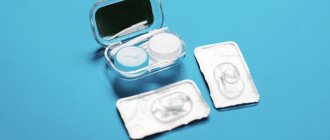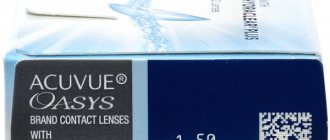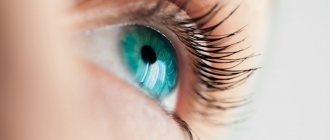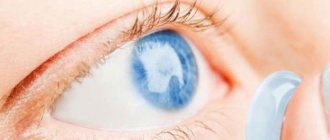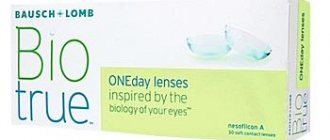Basic rules for wearing lenses
The human eye was not designed to interact with foreign objects.
With this in mind, manufacturers strive to make lenses as thin as possible and experiment with materials so as not to deprive the surface of the eye of the necessary moisture and contact with oxygen.
But a foreign object remains a foreign object and therefore you need to remember about the wearing mode, the permissible periods of wearing, and also that the use of lenses is not acceptable in all situations.
Sleeping in lenses
Do you sleep with lenses on? Maybe this is why you feel discomfort and dry eyes? Don't sleep with your lenses on, especially if you wear them during the day.
Using extended-wear lenses means you can leave them on for several days, or even weeks, but it’s better not to get carried away. The eyes should rest at least during sleep.
No matter how good the lenses are, they interfere with the natural hydration of the surface of the eye, which can lead to dryness, irritation, redness and itching. In addition, tear fluid serves as a natural barrier against pathogenic bacteria.
If the eye is not washed with it sufficiently and for a long time, infection may begin.
Contact with water
Avoid eye contact with water while wearing lenses. Neither swimming, nor showering, nor even simple washing are allowed until the correction means are removed.
There are many microorganisms in the water that will only be happy to get into your eyes.
For swimming, it seems possible to use special tight-fitting goggles, but this is a compromise option. It is best to enter the water without lenses at all.
Dropped on the floor?
A lens that falls on a dirty floor should be immediately thrown into the trash. Few people would agree to swallow a piece that has been on the floor for fear of infection or out of simple disgust. Here we are dealing with something much more delicate and, if further used, much more dangerous.
You still won’t be able to wash it properly, so it’s better to throw it away and take a new one out of the package.
Cracks
Lenses with chips and cracks are also subject to disposal. If you feel discomfort when wearing, dryness, or burning in your eyes, remove the lens and examine it carefully. If any defects are found, replace it with a new one ahead of time.
Contact lens care
There is a certain set of requirements, the fulfillment of which is strictly mandatory, regardless of the type of lenses used. First of all, we are talking about hygiene rules, but not only about them.
During the day, lenses are exposed to the external environment and, at the same time, to the body itself. Proteins and fats from the surface of the eye settle on them, which become a breeding ground for bacteria. If the lenses are not cleaned and disinfected, then vision diseases may appear in the future.
Once a week, lenses (especially “continuous wear”) should be subjected to an enzyme cleaning procedure to remove adhering protein masses. To do this, place a cleaning tablet in the clean cups of the container filled with fresh solution, after which you can remove and wash the lenses as usual.
After closing the lids, shake the container and leave for 15 minutes. After this, take out the lenses, throw out the liquid, rinse the correction products again and put them in a refilled container until the next day.
But there are other dangers associated with the use of aerosols, non-recommended eye drops, etc. Remember: during use, a contact lens becomes an extension of your eye, and neglect of its care will inevitably affect your vision.
Terms of use
Follow the terms of use of lenses. If they are designed to last for two weeks, then they should be thrown out after two weeks. In some cases it may be necessary to do this ahead of schedule, but never later. Be sure to mark the day of the kit change on your calendar; You can also use the reminder function on your phone.
Contact with lens
Touching lenses is only allowed with dry, clean hands. It is best to pre-wash them with liquid antibacterial soap and rinse thoroughly. Moisturizing soap is harder to wash off and therefore worse: your hands should not contain unnecessary chemicals.
Dry your hands with a clean, lint-free towel. Regular kitchen or disposable paper napkins and towels are quite suitable. It is advisable to have it nearby when putting it on to blot your fingers moistened with the solution.
The fact is that it is easier for the lens to “jump” onto the surface of the eye from a dry surface, while sometimes it sticks to a wet surface.
Eye drops
Eye drops are allowed to be used only after consultation with an ophthalmologist. Many drops are intended for application exclusively to the open surface of the eye and their interaction with the lens material can cause damage to the latter.
Therefore, if you feel the need for additional hydration, ask your doctor for advice - he will tell you which brand to choose to feel comfortable.
Solution and container
The solution must be replaced daily. Overnight, floating in liquid, the lenses are cleaned of bacteria and protein films.
Returning them in the evening to the same “broth” is the same as washing several times in the same water. Spare your eyes, they will wear this later.
Change the container at least once a month. No matter how much you wash it, dirt and microorganisms still accumulate on the walls and ultimately make the containers unsuitable for further use.
The container itself is inexpensive, and some manufacturers of the solution put a free copy inside the box as a gift, and this is another argument in favor of timely replacement.
Prevention
Visit your ophthalmologist every six months for an eye exam and consultation on current issues. Regular examinations will reduce the risk of eye diseases and correct difficulties that arise during wearing.
Color change
Disinfectant solutions today are largely free of traditional preservatives such as thimerosal and chlorhexidine, so discoloration of contact lenses occurs less frequently than in the past. In most cases, the stain covers the entire contact lens and is distributed evenly over it, only in rare cases the color is uneven.
Brown and tan spots are usually caused by the presence of melanin and tyrosine. Nicotine can promote the appearance of melanin-like substances and also have a direct effect through cigarette smoke. Adrenaline and vasoconstrictors can also cause this coloration.
Thimerosal preservatives contain mercury, which can cause contact lenses to appear gray to light gray to dark gray. Chlorhexidine can cause contact lenses to appear yellow-green or gray-green in color, which fluoresce when exposed to ultraviolet light. Discoloration of a contact lens can be caused by medications. For example, epinephrine, when oxidized, can form melanin pigments, which have a dark brown color.
Rules for removing lenses
It is most convenient to put on and remove lenses at a table in front of a small mirror. This way you can control your movements, and if the lens slips off your finger or falls out of your eye, it will be easy to find.
- Train yourself to always start with the same eye (for example, the right one). This will prevent you from confusing the lenses from different eyes, which is especially important if their vision is different.
- Lenses removed from the blister or container are ready for use and do not require additional manipulation. Check each one to make sure it's facing the right way and put it on.
- It is extremely important to remember to rinse the empty container. Pour the solution out of it and rinse it fresh, then place the container upside down on a clean napkin. By evening it will be dry, clean and ready to use again.
- Remember that you should apply various aerosols (in particular, hairsprays or deodorants) before putting on correction products. Otherwise, you risk damaging them irrevocably with sticky particles.
- You need to apply makeup with your lenses already on. All cosmetics, including eyeliner, must be water-soluble. Be careful not to let any particles come into contact with your eyes to avoid discomfort. In addition, using the same cosmetics for a long time is not recommended.
Plaques and deposits that give a geographical pattern
Organic plaques in the form of plaques in many cases consist of several layers. Often their inner layer is formed by unsaturated fatty acids (tear fats), the middle layer consists of mucin, and the outer layer is protein.
Inorganic deposits are white in color and have clearly visible boundaries. The form can be regular or irregular. These deposits are visible even to the naked eye; they are believed to consist of calcium, but in a much more intense content than in films. Crystalline deposits may be covered with a translucent film. Calcium, phosphate and carbonate ions accumulate on the surface of the lens and become insoluble, resulting in the formation of crystalline deposits, sometimes taking the form of granules.
Rules for putting on lenses
- Fill the containers in advance so that the removed lens can be removed immediately and without unnecessary delays. The less she is outdoors, the better.
- It is strictly forbidden to rinse and store lenses in plain water. There are special solutions for this, and your ophthalmologist will help you choose one. These liquids have disinfecting properties, while ordinary water not only does not kill microorganisms, but is itself teeming with them.
- Rinse the removed lens on both sides with the solution and rub gently with your finger for 10 seconds. The accuracy of the mechanical action is very important here, since we are talking about a surface in contact with the eye. It is necessary to clean off protein accumulations without damaging the correction product.
- Place a clean lens in the container and immediately screw the cap on to avoid accidental dust from the air, then proceed to remove the next one.
The following picture shows the main points that must be observed when properly caring for lenses:
Deposits in the form of individual (discrete) spots
The morphology and composition of such deposits are as follows: 1. The base adjacent to the polymer of the contact lens; consists of unsaturated fatty acids and calcium, which serves as a stabilizer. 2. The middle layer, which occupies most of the sediment, is like a dome; consists of cholesterol, cholesteryl esters and mucins. 3. Third layer, transparent; consists of proteins.
The etiology of the process may be different. Sometimes the cause is the individual chemical composition of tears, dry eye syndrome, low pH levels, poor cleaning of contact lenses, or the polymer from which the lens is made.
Large complex spots are called jelly bumps and their sizes range from 200 to 800 micrometers. Such deposits are extremely difficult to remove, especially when they grow into the matrix and are not just located on the surface of the contact lens. They can be removed by using intense oxidative and enzymatic cleaners, but once the contact lens is worn again, deposits will form in the same areas.
These deposits can cause a variety of symptoms. Possible weakening of vision, mechanical irritation of the palpebral conjunctiva (with concomitant follicular and papillary conjunctivitis), very rarely - minor injuries to the epithelium (if the deposit occurs on the back of the contact lens).


